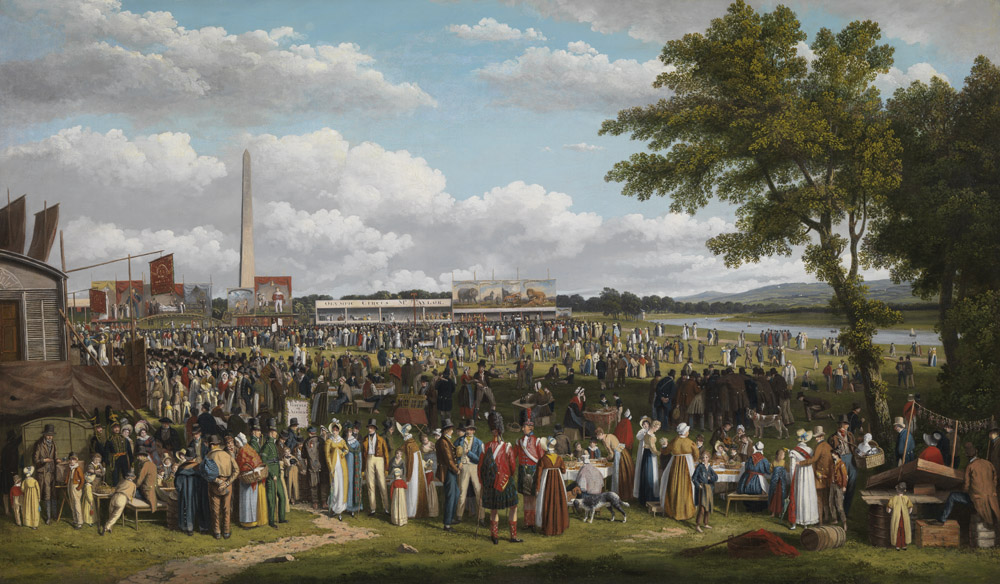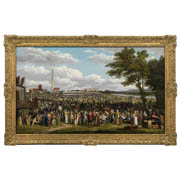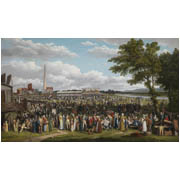Details
- Object type
painting
- Title
Glasgow Fair
- Artist/Maker
John Knox artist
- Culture/School
Scottish
- Place Associated
Scotland, Glasgow (place associated)
- Date
circa 1819-22
- Materials
oil on canvas
- Dimensions
overall: 876 mm x 1473 mm (unframed); 1080 mm x 1689 mm (framed)
- Description
-
Glasgow Fair is a very ambitious painting, complex in composition and astounding in the number of people portrayed: ladies in fine dresses with feathered hats and parasols; gentlemen with top hats and canes; working class women in aprons and bonnets; soldiers in uniform, including 42nd Royal (Highland) Foot Grenadiers, Glasgow Volunteers and 7th Hussars. There are over 1,000 figures individually delineated.
Knox was used to painting vast and complex scenes. During the period 1809-14 he produced at least six vast panoramas of Ben Lomond, Edinburgh, Dublin, Moscow, Gibraltar and Glasgow. These panoramas were exhibited in large wooden rotundas and took up some 3,000 square feet of canvas. On 2 May 1812 the Glasgow Courier, advertising the opening of Knox’s Dublin Panorama, noted the ambitious nature of the composition with its 'several thousand figures, many of them well known and celebrated characters.’
Glasgow Fair is a descendant of these popular panoramas. It documents Glasgow in the early years of its expansion, when trade, commerce, art and enterprise were flourishing. It includes the booths, sideshows and circuses of Glasgow Fair which was held annually at the foot of the Saltmarket, spilling over into Glasgow Green. Newspapers of the day, such as the Glasgow Free Press, Glasgow Sentinel and Scots Times, and contemporary reminiscences, describe the actors, dancers, musicians, clowns, acrobats, animal tamers, jugglers, boxers, illusionists, card tricksters, traders, freak shows, waxworks, chambers of horrors, shooting booths, merry-go-round rides and Punch and Judy shows that populated the fair. Knox includes many of these in his painting.
Other fascinating vignettes include an Italian seller of sculptural heads, men gathered around a cock fight, a couple of pickpockets, an organ grinder with his monkey, a blind fiddler, a woman dragging her drunk husband from a seller of alcohol and twins in matching clothes. The shows include 'Mr Taylor's Olympic Circus', which advertised tight rope dancing and equestrian displays, and 'Wombwell's Grand Collection of Beasts', the largest travelling menagerie in Britain. There are many adverts and placards including what seems to be an anti-slavery poster, referring to the Battle of Algiers, Britain’s 1816 attempt to end slavery practices of the Dey of Algiers, resulting in the freeing of 3,000 enslaved people. The well-dressed figures in the foreground may well be local merchants, businessmen or politicians with their families. Knox may have been making a reference to the business practices of these families and their involvement in the transatlantic slave trade.
The painting is full of social commentary. When advertised for sale in the Glasgow Herald (30 April 1860), Glasgow Fair was recognised as a 'very valuable' painting, 'a rare work of Art, and very suitable for a public collection'. It was exhibited in the Scottish History section of the International Exhibition in Glasgow in 1901 (no. 1880), lent by Thomas Clavering, and appears as an illustration in vol. 3 of George Eyre-Todd’s History of Glasgow (1934).
Trustee of the Hamilton Bequest Chris Primrose writes: ‘As a Glaswegian, the Glasgow Fair holiday has been in my psyche for as long as I can remember and was always the time of year when the whole City seemed to be more upbeat and joyful. This is one reason why this painting is my favourite but also the fascinating back story of how it was 'lost' for around 100 years having been mistakenly attributed to the artist, William Turner De Lond. There is so much going on in the foreground that I urge you to have a closer look. For me, this beautifully depicts the rich diversity and humour of the Glasgow I know and love.’
- Credit Line/Donor
Purchased with the support of the National Lottery through the Heritage Lottery Fund, Trustees of the Hamilton Bequest, Friends of Glasgow Museums and Sir Angus Grossart, November 2014
- ID Number
3718
- Location
In storage


